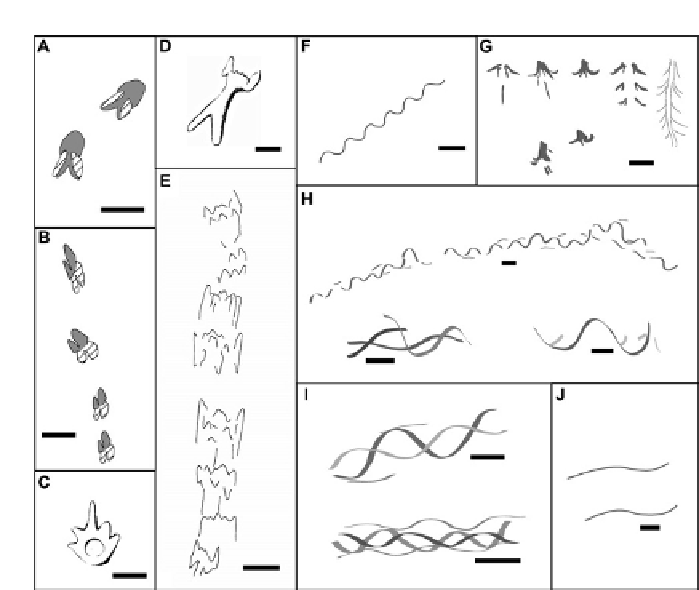Environmental Engineering Reference
In-Depth Information
FIGURE 5
Simplified drawings based on actual specimens of trace fossils from Connecticut River
valley (USA) varves. (A)
Surculichnus bifurcauda
in epirelief. Gray area is negative relief; hatched area
is positive relief. (B) Unknown arthropod trace fossil (UATF) 4 in epirelief. Gray area is negative relief;
hatched area is positive relief. (C) UATF 3 in positive hyporelief (cast). (D) UATF 2 in positive hypo-
relief (cast). (E) UATF 1 in positive hyporelief (cast). (F)
Undichna unisulca
. (G) Five morphotypes of
Broomichnium flirii
. (H) Three morphotypes of
Undichna britannica
.(I)Twomorphotypesof
Undichna simplicitas
.(J)
Undichna bina
. Scale bars in (A), (D), (G-J
¼
2 cm); (B, C, and E
¼
1cm);
(F
¼
10 cm). See
Benner et al. (2009)
for detailed explanations and interpretations of each trace fossil.
fossils, is coincident with a sedimentologically corroborated shift from mostly
glacial input to the lake to mostly non-glacial inputs (
Benner et al., 2009
). The
last identified stage in the succession, Stage 4 (NEVC year 7610;
13.51 ka
BP), coincides with a sedimentological shift to higher percentages of sand depo-
sition, probably indicating shallower lake environments as water levels dropped
or as the basin filled. These contain an abundance of fish breeding pits,
Piscich-
nus
, in addition to arthropod and other fish-produced trace fossils. The apparent
lack of small invertebrate traces (i.e.,
Cochlichnus
) in Stage 4 varves may be a
result of taphonomic factors (poor preservation in sand) rather than actual
abundance of the tracemaker. It is possible that the rate of stage transition (suc-
cession) increased as time passed in the valley after a significant reservoir of
organisms ready to inhabit newly exposed water ways had accumulated in ice-
free areas. Close observation of species assemblages in modern late-stage glaci-
ated valley lakes may help to elucidate these processes.






Search WWH ::

Custom Search